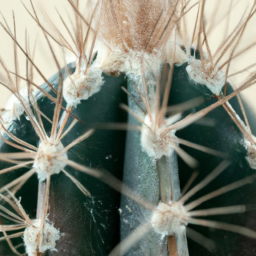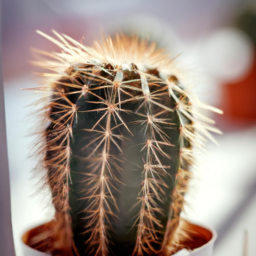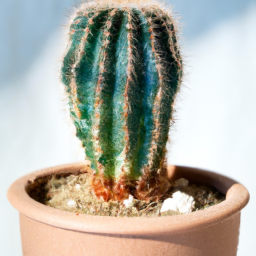
Are you looking to add some greenery to your indoor space? Indoor cactus types are a great option for those looking to bring a touch of the desert into their home. These low-maintenance plants come in a variety of shapes, sizes, and colors, making them a versatile choice for any indoor environment. In this blog post, we will explore some of the most popular indoor cactus types and provide tips on how to care for them. Whether you’re a seasoned plant parent or a beginner looking to add some greenery to your space, indoor cactus types are a great choice for adding some natural beauty to your home.
Popular Indoor Cactus Types for Beginners
Introduction
When it comes to adding greenery to your indoor space, cacti are a fantastic choice. Not only are they low-maintenance and easy to care for, but they also come in a wide variety of shapes, sizes, and colors. In this guide, we will explore some of the most popular indoor cactus types for beginners, so you can choose the perfect one for your home.
Types of Indoor Cacti
There are many different types of cacti that thrive indoors, each with its own unique characteristics. Here are some popular indoor cactus types that are perfect for beginners:
**1. Christmas Cactus (Schlumbergera)** – Christmas cacti are known for their vibrant blooms that typically appear around the holiday season. These cacti prefer bright, indirect light and well-draining soil. They are relatively low-maintenance and can add a pop of color to any indoor space.
**2. Bunny Ear Cactus (Opuntia microdasys)** – This cute cactus gets its name from its unique flattened pads that resemble bunny ears. Bunny ear cacti are easy to care for and can thrive in a variety of light conditions. They are perfect for beginners looking to add a quirky touch to their indoor space.
**3. Golden Barrel Cactus (Echinocactus grusonii)** – Golden barrel cacti are known for their striking golden spines and spherical shape. These cacti are slow-growing and can live for many years with proper care. They prefer bright, indirect light and well-draining soil, making them a great choice for indoor spaces.
**4. Zebra Plant (Haworthia attenuata)** – Zebra plants are small, compact cacti with distinctive white stripes that resemble a zebra’s stripes. These cacti are easy to care for and can thrive in low light conditions. They are perfect for beginners looking for a unique and eye-catching indoor plant.
Caring for Indoor Cacti
While cacti are known for their low-maintenance nature, they still require some care to thrive indoors. Here are some tips for caring for your indoor cacti:
**1. Light** – Most indoor cacti prefer bright, indirect light. Place your cacti near a sunny window where they can receive plenty of sunlight throughout the day.
**2. Watering** – Cacti are drought-tolerant plants and should be watered sparingly. Allow the soil to dry out completely between waterings, and be sure to use a well-draining potting mix to prevent root rot.
**3. Temperature** – Indoor cacti prefer warm temperatures during the day and cooler temperatures at night. Keep your cacti away from drafty windows or doors to prevent temperature fluctuations.
In conclusion, indoor cacti are a great choice for beginners looking to add some greenery to their indoor space. With their unique shapes, sizes, and colors, there is a cactus out there for everyone. By following these tips for care, you can enjoy your indoor cacti for years to come.

Care Tips for Different Indoor Cactus Varieties
Choosing the Right Indoor Cactus Variety
When it comes to choosing the right indoor cactus variety, there are a few factors to consider. First, think about the amount of sunlight your cactus will receive. Some cacti thrive in bright, direct sunlight, while others prefer indirect light. It’s important to match the sunlight requirements of your cactus with the conditions in your home.
Next, consider the size of the cactus. Some cacti are small and compact, making them perfect for windowsills or small spaces. Others can grow quite large and may require more room to spread out. Make sure you choose a cactus variety that fits the space you have available.
Finally, think about the care requirements of the cactus variety you’re interested in. Some cacti are low-maintenance and can thrive with minimal care, while others may require more attention. Choose a cactus variety that matches your level of experience and the amount of time you can dedicate to caring for your plant.
Caring for Your Indoor Cactus
Once you’ve chosen the right indoor cactus variety for your home, it’s important to provide the proper care to help it thrive. Here are some general care tips that apply to most indoor cactus varieties:
1. Light: Most indoor cacti prefer bright, indirect sunlight. Place your cactus near a window where it can receive plenty of light throughout the day. Rotate your cactus occasionally to ensure even growth.
2. Watering: Cacti are desert plants and are adapted to survive in dry conditions. Water your cactus sparingly, allowing the soil to dry out completely between waterings. Overwatering can lead to root rot, so it’s important to err on the side of underwatering.
3. Soil: Use a well-draining cactus mix for your indoor cactus. This will help prevent water from pooling around the roots and causing rot. You can also add perlite or sand to regular potting soil to improve drainage.
4. Temperature: Most indoor cacti prefer warm temperatures during the day and cooler temperatures at night. Keep your cactus away from drafts or cold windows during the winter months.
5. Fertilizing: Cacti are not heavy feeders, so they don’t require frequent fertilization. Use a diluted cactus fertilizer once a month during the growing season to provide nutrients to your plant.
Specific Care Tips for Different Indoor Cactus Varieties
While the general care tips above apply to most indoor cactus varieties, there are some specific care requirements for certain types of cacti. Here are a few examples:
1. Christmas Cactus: Christmas cacti are popular indoor plants known for their colorful blooms. These cacti prefer bright, indirect light and slightly more water than desert cacti. Keep your Christmas cactus in a cool location with temperatures around 60-70°F for best results.
2. Easter Cactus: Easter cacti are similar to Christmas cacti but bloom in the spring. These cacti prefer cooler temperatures and higher humidity levels. Water your Easter cactus more frequently during the blooming period to encourage flower production.
3. Zebra Plant: Zebra plants are unique cacti with striking white stripes on their green stems. These cacti prefer bright, indirect light and regular watering during the growing season. Reduce watering in the winter months to mimic their natural dormancy period.
By following these care tips for different indoor cactus varieties, you can enjoy a thriving and beautiful cactus collection in your home. Remember to tailor your care routine to the specific needs of each cactus variety and enjoy watching your plants grow and flourish.

Best Indoor Cactus Types for Low Light Environments
Introduction
When it comes to choosing the best indoor cactus types for low light environments, there are a few key factors to consider. Cacti are known for their ability to thrive in dry, arid conditions, but not all cactus varieties are suited for low light situations. In this guide, we will explore some of the best indoor cactus types that can thrive in low light environments, making them perfect additions to your home or office.
Types of Cacti for Low Light Environments
One of the best indoor cactus types for low light environments is the Christmas cactus (Schlumbergera). This cactus is native to the rainforests of Brazil, so it is used to lower light levels. The Christmas cactus produces beautiful flowers in shades of pink, red, or white, making it a popular choice for indoor gardeners. This cactus prefers indirect sunlight and can thrive in low light conditions, making it a perfect addition to any room in your home.
Another great indoor cactus for low light environments is the Zebra cactus (Haworthia attenuata). This cactus is native to South Africa and is known for its striking zebra-like stripes on its leaves. The Zebra cactus is a low-maintenance plant that thrives in low light conditions, making it an excellent choice for beginners or those with limited natural light in their homes. This cactus prefers indirect sunlight and should be watered sparingly to prevent root rot.
The Snake plant (Sansevieria) is another excellent indoor cactus type for low light environments. This cactus is native to West Africa and is known for its tall, upright leaves that resemble a snake. The Snake plant is a hardy plant that can thrive in low light conditions, making it a perfect choice for offices or rooms with limited natural light. This cactus prefers indirect sunlight and should be watered sparingly to prevent overwatering.
Tips for Caring for Indoor Cacti in Low Light Environments
When growing indoor cacti in low light environments, it is essential to provide the right conditions for them to thrive. Here are some tips for caring for indoor cacti in low light environments:
1. Choose the right cactus varieties that are suited for low light conditions, such as Christmas cactus, Zebra cactus, and Snake plant.
2. Place your indoor cacti near a window that receives indirect sunlight, as cacti still need some light to thrive.
3. Water your indoor cacti sparingly, as overwatering can lead to root rot. Allow the soil to dry out completely between waterings.
4. Use a well-draining cactus mix for planting your indoor cacti to prevent waterlogged soil.
5. Rotate your indoor cacti occasionally to ensure even growth and exposure to light.
By following these tips and choosing the right indoor cactus types for low light environments, you can enjoy beautiful and thriving cacti in your home or office. Remember to provide the right conditions and care for your indoor cacti to ensure they thrive and bring a touch of nature indoors.
Here’s the Summary Snapshot
Are you looking to add some greenery to your indoor space but don’t have a green thumb? Indoor cacti might just be the perfect solution for you! Cacti are low-maintenance plants that require minimal watering and can thrive in a variety of indoor environments. There are many different types of indoor cacti to choose from, each with its own unique shape, size, and color.
One popular indoor cactus type is the Echinopsis, also known as the Easter Lily cactus. This cactus features large, showy flowers that bloom in the spring and summer, adding a pop of color to your indoor space. Another popular choice is the Mammillaria, which is known for its small size and clustering growth habit. With so many options to choose from, you’re sure to find the perfect indoor cactus to brighten up your home or office space.
Frequently Asked Questions (FAQ):
Q1: What are some common types of indoor cacti?
A1: Some common types of indoor cacti include the Christmas Cactus, Easter Cactus, Zebra Cactus, and the Moon Cactus.
Q2: How do I care for indoor cacti?
A2: Indoor cacti require bright, indirect sunlight, well-draining soil, and infrequent watering. Make sure to allow the soil to dry out completely between waterings.
Q3: Can indoor cacti thrive in low light conditions?
A3: While indoor cacti prefer bright, indirect sunlight, there are some varieties that can tolerate lower light conditions. Consider placing them near a window that receives some sunlight throughout the day.
Q4: Do indoor cacti require special soil or fertilization?
A4: Indoor cacti thrive in well-draining cactus or succulent soil. Fertilize them sparingly with a diluted cactus fertilizer during the growing season.
Q5: Are indoor cacti prone to pests or diseases?
A5: Indoor cacti are generally low-maintenance and resistant to pests and diseases. However, overwatering can lead to root rot, so it’s important to ensure proper drainage to prevent this issue.
Dr. Olivia Green is a botanist with over two decades of experience in indoor plant cultivation. She holds a Ph.D. in Plant Biology and has dedicated her career to researching plant behavior in controlled environments. Dr. Green is passionate about helping plant enthusiasts master the art of indoor gardening through her extensive knowledge and practical insights.


